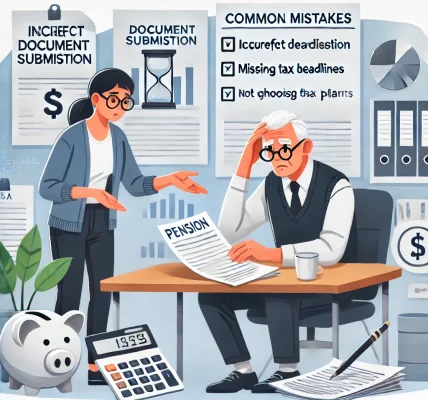Introduction
A pension scheme is an essential financial tool for ensuring financial stability after retirement. Government pension schemes are one of the most secure ways to build a retirement corpus as they are backed by the government, ensuring reliability and guaranteed benefits. However, enrolling in a government pension scheme can seem complex due to the multiple processes involved.
This guide provides a step-by-step breakdown of how to enroll in a government pension scheme in India, covering eligibility, documentation, application processes, and key considerations to ensure a seamless enrollment experience.
Understanding Government Pension Schemes
Popular Government Pension Schemes in India
There are several government-backed pension schemes available for different categories of individuals. Below are some of the most prominent schemes:
- National Pension System (NPS) – Open to all Indian citizens, providing market-linked returns.
- Employees’ Provident Fund (EPF) & Employees’ Pension Scheme (EPS) – For salaried employees in the organized sector.
- Atal Pension Yojana (APY) – Aimed at workers in the unorganized sector.
- Indira Gandhi National Old Age Pension Scheme (IGNOAPS) – Provides financial assistance to low-income senior citizens.
Each scheme has different eligibility criteria, benefits, and procedures for enrollment, which we will cover in detail.
Step 1: Determine Your Eligibility
Before enrolling in a government pension scheme, it is crucial to check whether you meet the eligibility criteria. Below are the general eligibility requirements for each scheme:
| Pension Scheme | Age Requirement | Employment Type | Income Criteria |
|---|---|---|---|
| NPS | 18 to 70 years | Salaried & Self-Employed | No restriction |
| EPF/EPS | No specific limit | Salaried (Private/Public Sector) | Mandatory for those earning ₹15,000/month or more |
| APY | 18 to 40 years | Unorganized Sector Workers | No formal income limit |
| IGNOAPS | 60 years & above | Unemployed/Low-income | Below poverty line (BPL) families |
If you meet the criteria for a particular scheme, you can proceed with the enrollment process.
Step 2: Gather the Required Documents
Different pension schemes require different documents for registration. Below is a general list of documents required for most government pension schemes:
✅ Identity Proof – Aadhaar Card, Voter ID, Passport, or PAN Card. ✅ Address Proof – Aadhaar Card, Ration Card, Utility Bills. ✅ Income Proof – Salary slips, IT returns, or a self-declaration for schemes like APY. ✅ Age Proof – Birth Certificate, Aadhaar Card, or School Leaving Certificate. ✅ Bank Account Details – Passbook copy or cancelled cheque (as pension payments are directly credited to bank accounts). ✅ Photographs – Passport-size photographs for application forms. ✅ Employment Details – Salary slips, employer declaration (for EPF/EPS applicants).
Having these documents ready will speed up the application process and prevent delays.
Step 3: Choose Your Enrollment Method
Most government pension schemes offer multiple ways to enroll. You can choose from:
- Online Enrollment – Available for schemes like NPS and APY through government portals and authorized banks.
- Offline Enrollment – Through designated bank branches, post offices, or employer-registered EPFO offices.
- Employer-Based Enrollment – For schemes like EPF/EPS, which are facilitated by employers.
Below, we detail how to enroll in each scheme.
Step 4: Enrollment Process for Each Scheme
A. National Pension System (NPS)
✅ Visit the official website www.npscra.nsdl.co.in or enroll via banks/post offices. ✅ Select an authorized Point of Presence (POP) (banks, financial institutions, or online service providers like eNPS). ✅ Fill the NPS registration form with personal details. ✅ Submit KYC documents and select an investment option (Active or Auto choice). ✅ Make the first contribution (minimum ₹500 per contribution or ₹1000 annually). ✅ Receive your Permanent Retirement Account Number (PRAN) and login details.
B. Employees’ Provident Fund (EPF) & Employees’ Pension Scheme (EPS)
✅ If salaried, check if your employer is registered with EPFO. ✅ Submit Form 11 and Aadhaar-linked UAN (Universal Account Number) to your employer. ✅ Employer submits EPF & EPS registration through the EPFO portal. ✅ Contributions are deducted automatically from salary every month. ✅ Track pension contributions through the EPFO Member Portal.
C. Atal Pension Yojana (APY)
✅ Visit your bank or post office offering APY enrollment. ✅ Fill APY enrollment form with Aadhaar, mobile number, and bank details. ✅ Choose your pension amount (₹1,000 to ₹5,000 per month). ✅ Enable auto-debit from the linked bank account. ✅ Receive confirmation and APY subscriber ID.
D. Indira Gandhi National Old Age Pension Scheme (IGNOAPS)
✅ Visit the local Gram Panchayat/Municipal Office. ✅ Submit an application form with income certificate and age proof. ✅ Verification is done by the concerned authorities. ✅ If eligible, pension payments begin in the beneficiary’s bank account.
Step 5: Track and Manage Your Pension Account
Once enrolled, you should actively track your pension contributions and benefits:
✔️ For NPS – Use NPS CRA portal to check balance and investment growth. ✔️ For EPF/EPS – Access the EPFO Member Portal to check contributions. ✔️ For APY – Track contributions via bank statements and SMS alerts. ✔️ For IGNOAPS – Check payments via bank updates or local authorities.
Timely tracking ensures that your contributions are credited correctly and that you can make necessary adjustments if required.
Conclusion
Enrolling in a government pension scheme is a crucial step toward securing your financial future after retirement. Whether you choose NPS, EPF/EPS, APY, or IGNOAPS, following the right process ensures a hassle-free registration.
To sum up: 📌 Choose the right pension scheme based on eligibility and financial goals. 📌 Prepare necessary documents to avoid delays. 📌 Opt for online or offline enrollment based on your convenience. 📌 Track your contributions to ensure timely pension benefits.
By taking the right steps today, you can ensure a financially secure and stress-free retirement in the future



